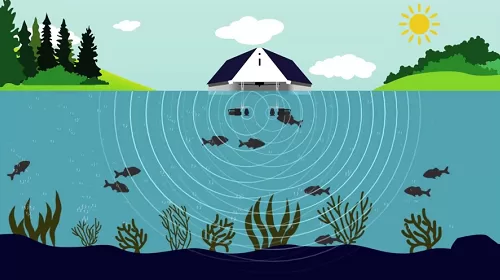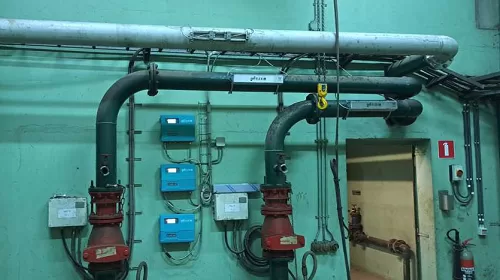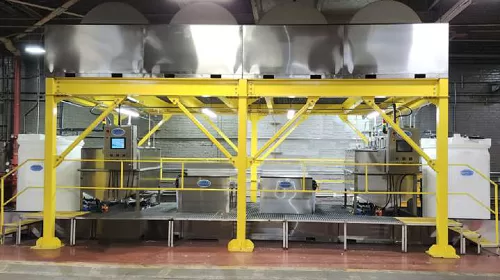INTRODUCTION
Water, which was perceived as a plentiful resource until the last century and the notion of conserving or reusing water was not given much serious consideration, moving towards the latter part of the preceding century, this perspective began to shift. Presently, water is recognized as one of the most crucial resources in both industrial and domestic sectors. While there is significant emphasis on purification and treatment for recycling or reuse, insufficient attention is often paid to maintaining water quality parameters, particularly concerning bacterial and biomass/algae growth during storage. Controlling these parameters (biomass/algae and microorganisms) is essential depending on the intended use of stored water.
Furthermore, Bloom-forming cyanobacteria, commonly referred to as blue-green algae, present a significant threat to both inland waters and estuarine environments when left unaddressed and this Harmful algal blooms (HABs), though occurring naturally, have witnessed a troubling surge in occurrence across lakes, reservoirs, and oceans in recent times. This global escalation of HABs, driven by harmful algal species, has evolved into a significant environmental concern. They have adverse effects on aquatic ecosystems and public health leading to fish mortality, animal deaths, human health risks, and disruptions in food and water supplies. The increase in the frequency, severity, duration, and geographic spread of these blooms correlates closely with the rise in CO2 levels and global temperatures. Increasing global temperatures, changing precipitation patterns, and more frequent and severe droughts collectively contribute to the spread of CyanoHABs. Prominent examples include the Bargi and Gandhisagar Dams in Madhya Pradesh, Ukai Dam in Gujarat, Stanley Reservoir in Tamil Nadu, and Chilika Lagoon in Odisha, as well as coastal waters along India’s eastern and western coasts. A study conducted in 2012, which examined CyanoHAB occurrences in India, revealed a notable increase of up to 15 percent over the preceding 12 years. It is plausible to assume that the frequency of CyanoHAB occurrences in India has continued to rise since 2012.
In the industrial context, biofilm poses a significant challenge in water systems. It develops on the inner surfaces of storage tanks and can lead to complete blockage of pipelines, pumps, or filtration equipment if left unchecked. The formation of biofilm is a highly intricate process. Once it establishes a stable slimy foundation on the surfaces of storage vessels, it becomes a haven for bacteria growth, accumulating organic debris from the water to sustain microbial activity. Consequently, it rapidly expands into a thick layer that can intermittently detach and obstruct water flow lines and pumps. Moreover, these biofilm deposits accelerate corrosion. Treatment typically involves chemical based routes such as coagulation, settling, and the addition of chlorine/ozone or specific chemicals. However, elevated levels of biomass or algae result in increased consumption of these chemicals. Conversely, preventing the formation and uncontrolled growth of biofilm poses significant challenges and expenses. Effective control of biofilm on cooling tower surfaces and sumps is crucial to prevent corrosion throughout the process lines and equipment such as heat exchangers, pumps, and filters.
ULTRASOUND: A CHEMICAL-FREE NON-INVASIVE WAY OF BIOMASS CONTROL
Ultrasound encompasses sound waves beyond the upper audible threshold of human hearing (20 kHz). At designated frequencies, these waves hold the capacity to manage algae growth. For a considerable time, it has been recognized that ultrasound possesses the ability to eliminate microorganisms and algae in water. Nonetheless, the widespread adoption of ultrasound technology has been hindered by its substantial energy requirements and challenges in technical feasibility for large-scale implementation. However, in recent years, this chemical-free, environmentally friendly solution has been garnering increased attention owing to its straightforward application, extended service life, and minimal maintenance needs.
There is a distinction between high-power ultrasound that causes cavitation and the low-power ultrasound. The first category system operates at high power, utilizing cavitation as its primary mechanism to effectively eradicate algae and microorganisms. However, it demands significant investment and energy. Typically, these ultrasound systems are installed within flowing water lines.
The second type of ultrasound devices operate on a fundamentally different principle compared to their high-power predecessors. They are characterized by simplicity and remarkably low power consumption. Operating at levels significantly below the cavitation threshold, these devices do not rely on cavitation to eliminate algae and microorganisms. Instead, they proactively inhibit the growth of these organisms. Unlike high-power systems, these devices are typically installed in static bodies of water. Through the continuous, gentle vibration of random multiple frequencies generated by the ultrasound system, these low-power devices effectively disrupt algae colonies, impeding their reproductive cycles, disturbing the float-sink cycle of cyanobacteria and preventing the formation of biofilm on surfaces. The straightforward installation process, minimal initial investment, low energy consumption, reduced maintenance requirements, and prolonged lifespan have contributed to a notable increase in the adoption of low power ultrasound devices in recent times. The emergence of low-power ultrasound systems for algae control began at the turn of the century, but it wasn’t until the last decade that their widespread adoption took hold. With an escalating number of systematic reports detailing large-scale field trials across various regions worldwide, these systems have demonstrated their efficacy and costeffectiveness. Initially employed primarily for algae growth reduction, it also quickly became apparent that these systems were highly effective in biofilm control as well.
The following section describes an advanced ultrasound based algae control system and its working mechanism followed by some field studies undertaken by Prasinos Tech Innovations Pvt. Ltd.
SWANCAV: A SMART ALGAE CONTROLLER
SwanCav comprises a group of advanced ultrasonic algae control devices that efficiently eliminate algal biomass growth and prevent biofilm formation, completely replacing the need for algicides. This significant contribution aids in the restoration of water bodies. With multiple models featuring varied configurations and specifications tailored to specific applications, SwanCav emerges as the premier solution for algae remediation across industries, large water surfaces, and smaller bodies of water.
It operates on the mechanism of very low power variable frequency ultrasonic wave that prevents the growth for both algae and microorganisms. The continuous mild vibration generated by the ultrasound system reduces the colonies of algae thereby interferes with their reproductive system and prevents the deposit of biofilm on the surface. Algae cells float in the water column in a vertical movement while accessing the sunlight from surface during day time and acquiring the nutrients from the bottom at night. With a varying frequency range as emitted from the submerged transducers, the ultrasound restrict their vertical movement by resonating with their frequency of vibration and cause damage to their reproductive mechanism without cell breakage. Fig. 1 below shows how the sound wave emitting from the ultrasonic transducers are modulating the buoyancy of the algae cells and restricting their vertical movements whereas Fig. 2 shows the pictorial view of SwanCav.
UNDERSTANDING THE SCIENCE BEHIND AND THE OPERATING PRINCIPLES THE SMART BUOY
- Multiple ultrasonic transducers covering 360 degree surrounding the buoy and emitting ltrasound waves at a varying frequency range (20-60 kHz)
- Integrated solar panels for using solar energy as the power source with power storage and charge controller
- Multiple water quality monitoring probes for in-situ water quality measurements
- UV-resistive floaters fitted to the platform
- Integrated anchoring facility
- Integrated alarm system for security
The major areas of applications of this device include:
- Recreational lake/large pond
- Industrial water storage
- Swimming pool/pond at golf course
- Aquaculture
- Municipal water storage
- Irrigation reservoir
- Hydroelectric dam
A CASE STUDY
Pimpri-Chinchwad is a city in the Indian state of Maharashtra. The city is about 15 km (9.3mi) northwest of the historic city of Pune. Under Pimpri-Chinchwad Municipal Corporation, also known as “PCMC”, Chikhali Sewage Treatment Plant (capacity of 36 MLD) plays a vital role in treating the sewage of the Pimpri-Chinchwad city mostly the raw water collected from Newale Wasti Pump House. Fig. 3 shows the overall process flow of the sewage water treatment which primarily uses Extended aeration process. Post treatment, the treated water is stored in a lake spanned over an area of 3.8 acres and used for recreational purpose, such as boating, gardening, and other non-potable purposes such as cleaning, toilet washing etc.
The primary challenge in restoring this water body was the frequent occurrence of algae and algal blooms, which not only marred its aesthetic appeal but also leads to:
- Reduced dissolved oxygen levels or complete absence of it,
- Decreased transparency,
- Elevated chlorophyll content,
- Foul odors
- Unsuitable for aquatic life
Such a large and uneven water body is much prone to algae growth and accumulation. There is no practical way to control this except by manual cleaning. SwanCav is the only alternative solution to frequent cleaning. Also, despite attempting other conventional methods such as aeration and chemical algicides, the management sought a sustainable, chemical-free solution that wouldn’t harm the environment. Owing to that, a field trial was conducted with the advanced buoy- SwanCav for preventing algal blooms and restoring water quality in the water body.
Remarkably, visible improvements were observed.
There are two treatment units in the plant and from both the units outlet, the treated water comes and is stored in the lake inside.
- Reduction in Biochemical Oxygen Demand (BOD) to below 5 mg/L
- Minimal turbidity and chlorophyll content
- Elimination of foul odors
- Healthier aquatic lives and eco-habitats
The observations are:
- Within few days after installation, some debris were found floating on the water surface generated from dead algae already present in the water body.
- After removing those debris, significant improvement was observed in terms of DO, pH and transparency of the water.
- The BOD level reduced from 9.2 to below 8 mg/L which is well within the State Pollution Control Board Limit.
Considering the Techno-economic analysis of SwanCav, it is completely solar power operated with battery back-up, the installation and maintenance cost is also minimal. Also no supervision is required. The system is indigenous and self-operated.
CONCLUSION
Utilizing advanced ultrasonic technology, the device which emits high-frequency sound waves is capable of disrupting algal cell structures, effectively inhibiting their growth and proliferation. By targeting algae at its source without the use of chemicals or harmful additives, this device offers an effective approach to water management. In spite of all, this technology is not yet grown or established in commercial scale due to various challenges such as high power consumption, high attenuation rate of the sound wave, possible unknown side effects on other aquatic lives over long exposure and difficulty to scale up. Alternatively, low power ultrasonic algae control devices offer an innovative solution to combat algae proliferation in various aquatic environments. By emitting low-frequency ultrasonic waves, these devices disrupt the growth and reproduction cycles of algae without harming other aquatic organisms. The gentle yet effective nature of these waves ensures minimal energy consumption while effectively managing algae blooms. Operating at low power levels makes them environmentally friendly and costeffective alternatives to traditional treatment methods. These devices are versatile, suitable for use in ponds, lakes, and even wastewater treatment facilities, providing a sustainable approach to algae management while preserving the ecological balance of aquatic ecosystems.





